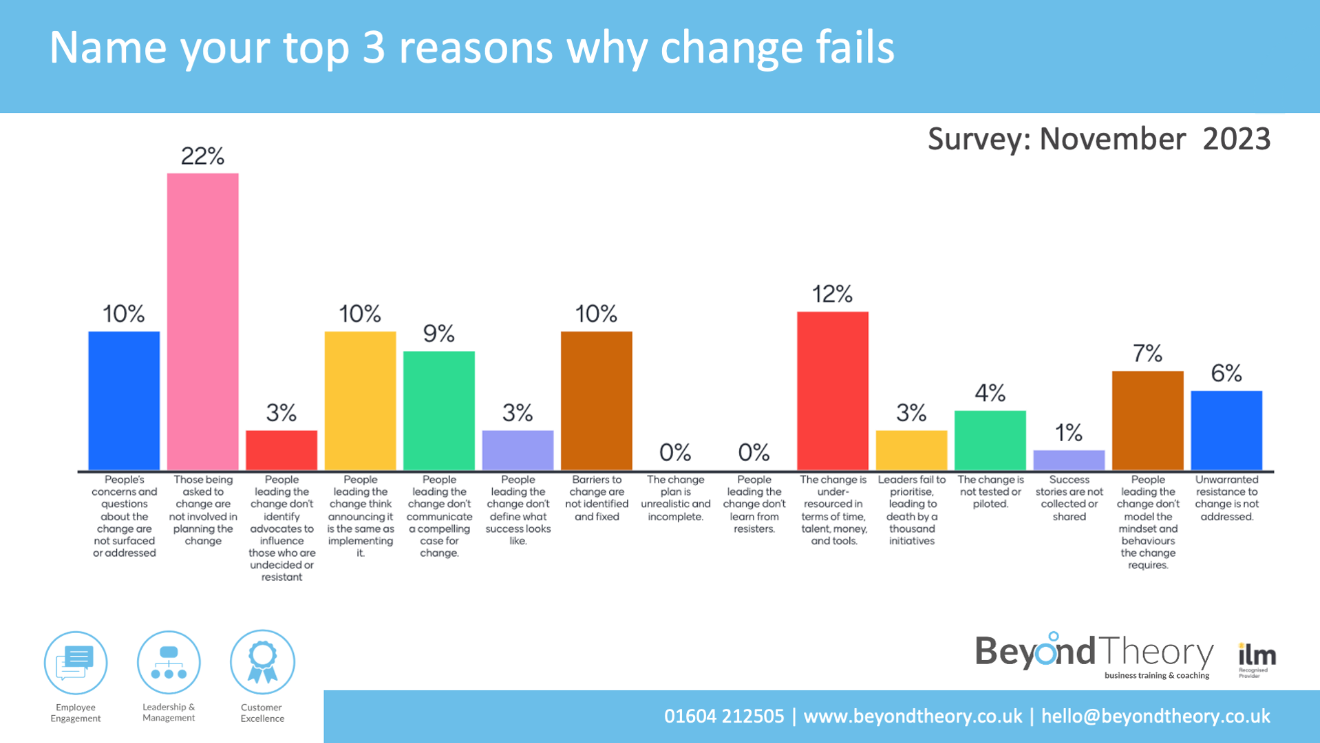Why does change fail in organisations?

Why does change fail in organisations?
For the past 3 months we have been delivering a series of masterclasses themed on emotionally intelligent leadership. Our last masterclass focused on Managing the Human Side of Change. During this session, we asked each of the 23 managers taking part to vote on what they feel are the top three reasons why organisational change fails.
Change is the only constant. Nothing is forever. If you are standing still then you are going backwards. These are all phrases that many of us have heard many times.
So, if change is so prevalent in organisations, why does it go so wrong so many times? The Chartered Institute of Personal & Development (CIPD) reckon that 70% of change initiatives fail to deliver.
With this question in mind, we engaged our audience of 23 managers to vote anonymously, using their mobile phones, for their 3 top reasons as to why change in organisations fail. Each manager was given the same 15 options.
What were the questions in the survey?
These were:
- People’s concerns and questions about the change are not surfaced or addressed.
- Those being asked to change are not involved in planning the change.
- People leading the change don’t identify advocates to influence those who are undecided or resistant.
- People leading the change think announcing it is the same as implementing it.
- People leading the change don’t communicate a compelling case for change.
- People leading the change don’t define what success looks like.
- Barriers to change are not identified and fixed.
- The change plan is unrealistic and incomplete.
- People leading the change don’t learn from resisters.
- The change is under-resourced in terms of time, talent, money, and tools.
- Leaders fail to prioritise, leading to death by a thousand initiatives.
- The change is not tested or piloted.
- Success stories are not collected or shared.
- People leading the change don’t model the mindset and behaviours the change requires.
- Unwarranted resistance to change is not addressed.
The managers were asked to vote about change in organisations in general rather than within their own company. However, many cited examples of when these reasons could be related to their own place of work.
Of course, each of the 15 reasons are extremely valid in their own right. However, what this survey uncovered was where to focus attention to help mitigate the risk of change failing.

From the survey, by far the most popular choice was ‘Those being asked to change are not involved in planning the change.’ The next most popular choice was ‘The change is under-resourced in terms of time, talent, money, and tools’, followed closely by ‘People’s concerns and questions about the change are not surfaced or addressed’, ‘People leading the change think announcing it is the same as implementing it’, ‘Barriers to change are not identified and fixed’ and ‘People leading the change don’t communicate a compelling case for change’.
So if you canvassed opinion in your workplace how would your survey shape up?
An interesting question. What's stopping you from finding out how your people feel how change is led and managed in your organisation?
Summary
The message in our training on change management is very much that change happens best when people are involved in the change. Of course, leaders need to set the direction and pace of the change. However, people do not like change being done to them. Instead, people like to be involved, understand and contribute to how a change can be implemented.
Being an emotionally intelligent leader is very much about understanding how you feel and others feel about change. People need to be bought into change. If not, then even if the change is implemented, people won’t feel invested or committed.
Paul Beesley, director and senior consultant
Beyond Theory

